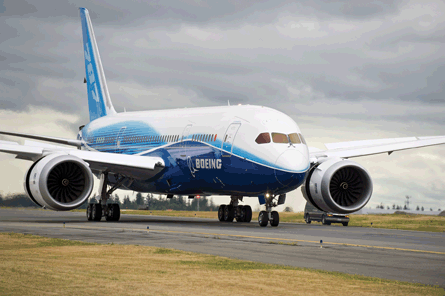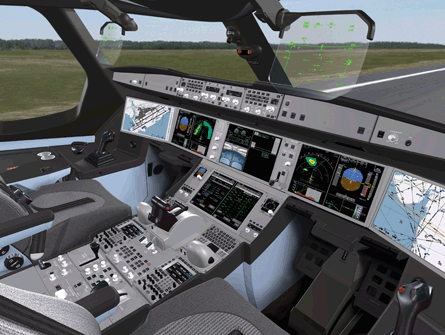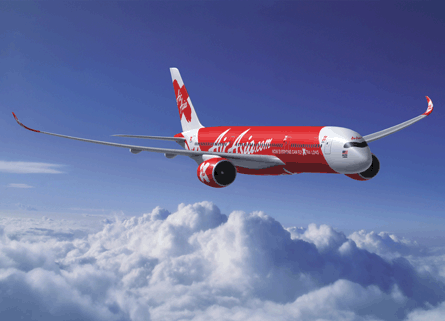For the Airbus A350 programme, 2009 has been a year of consolidation as its rival in Seattle's Dreamliner development effort lurched from crisis to crisis. The only consoling factor for Boeing is the serious prospect that the 787 should finally get airborne by the end of the year.
The XWB is midway through a critical and intense development programme that will lead to final assembly of the first example of the lead variant, the -900, beginning in mid-2011. Key milestones that must be completed over the next 18 months or so include the completion of the detailed design as well as the finalising of the baseline specification for the smaller and larger versions of the Rolls-Royce Trent XWB-powered family, the -800 and -1000, respectively.
In parallel, Airbus has been working on the production plan for the aircraft's carbonfibre structure as it prepares for fabrication of the initial components, which is due to begin soon.
 |
|---|
© Boeing |
As with the 787 at this stage of its development, the A350 appears to progressing smoothly. Late last year the -900 achieved the key "maturity gate (MG) 5" milestone on schedule, which represented the detailed definition freeze. This version will be the first to fly, in early 2012. Qatar Airways is due to receive the first aircraft, in the second half of 2013.
The only major headache the design team has revealed so far was the configuration of the rear galley. This has now been finalised slightly later than planned after some customers rejected the initial layout. Next on Airbus's agenda is completing MG5 for the -800, which is due by year-end.
One key development Airbus will introduce on the A350 is a new electronic flight bag philosophy. Dubbed "class 2-plus", the system combines integrated hardware with the ability to dock a laptop computer, which will be operated using the aircraft's on-board controls. It has been evolved from the A380's on-board information system, which is fully integrated class 3 EFB.
Meanwhile, in Seattle, Boeing has run into almost countless obstacles that have prevented the 787 from being capable of beginning its flight-test programme. After the production issues that dogged the programme in 2007-8, the Dreamliner looked set to take off in line with its revised schedule of mid-2009 - almost right up until the day it should have flown.
As the industry waited with bated breath for the maiden sortie, the airframer revealed the now infamous "side-of-body" structural issue. It took Boeing two months to get its head around how it would tackle the problem, and the impact it would have on the schedule.
 |
|---|
© Airbus |
The clarification came through from Seattle on 27 August, when Boeing confirmed that "Dreamliner One" (ZA001) should finally take to the air by the end of 2009. In late September it began modifying the first two 787s - ZA001 and the static test airframe, ZY997.
The entire process of preparation, installation and restoration is expected to take about three months, following which ZY997 will undergo static tests to validate the design of the modification to clear ZA001 for flight.
The knock-on effect of the latest problem is that deliveries will begin in the fourth quarter of 2010, adding six to nine months to almost two years of delays already incurred. Development of the 787-9 has also slipped, with deliveries to launch customer Air New Zealand sliding from early 2013 to later the same year.
With the woes being suffered by the 787-8, the status of the medium-range -3 looks particularly uncertain. In mid-2009 Japan Airlines - one of just two customers for the -3 - dropped its order in favour of the baseline 787-8, leaving just All Nippon Airways with the variant (28 orders) on its books. The -3 was launched along with the -8 at the start of the programme specifically to meet the Japanese airlines' requirement for a high-density configuration.
Despite the JAL move, Boeing says it remains committed to building the variant, which has lower weights and a trimmed wingspan for use at space-constrained gates. In fact United Airlines has emerged as a potential client, with it eyeing the -3 as replacement for its 757, 767 and 777 fleets on US domestic routes.
Boeing had planned the 787-3 to follow straight after the -8, but development has been postponed as it worked to get the programme back on track and moving forward with the -9.
In the wake of all the production issues, the 787 production ramp-up has been slowed, with the plan of achieving 10 787s a month being pushed back by a year to the end of 2013. However, unless a second final assembly line is introduced, the company will only be able to produce seven 787s a month at its existing Everett facility.
If the delay woes were not painful enough, Boeing has also had to take a $2.5 billion writedown after it declared that the first three of six flight-test 787-8s "have no commercial market value beyond the development effort due to the inordinate amount of rework and unique and extensive modifications made" to them.
CARSON A CASUALTY
Boeing Commercial Airplanes president Scott Carson was a casualty of the fall-out from the bungled programme, having retired and been replaced by Jim Albaugh, his counterpart at the Integrated Defense Systems division.
Boeing's production woes with the carbonfibre Dreamliner will not have gone unnoticed in Toulouse, and an important task Airbus has undertaken this year has been the validation of the build process for its own composite airliner. With the XWB, the airframer is effectively re-inventing the way it puts together an airliner and to understand the issues it faces, it has run a "demonstrators programme".
Airbus plants in Germany and France have built several fuselage barrel demonstrators, which will be used to support the certification process and demonstrate the efficiency of use of common tools and processes.
After the flood of sales that both new airliners have enjoyed in recent years, 2009 has been relatively quiet. While all orders are down significantly because of the difficult trading conditions, the main reason for the slowing of new sales for the Dreamliner and XWB is more to do with the phase that each programme is at.
 |
|---|
© Airbus |
With both aircraft types having been through their "launch cycle" from a sales perspective, they can both boast impressive backlogs - the 787's stands at 850 aircraft, while the A350's total is 493.
This means that the first major batches of slots are well into the next decade for both aircraft, and many potential customers are now taking a tentative approach as they await confirmation that the hardware can deliver what the brochures promise.
In the first nine months of 2009, the A350 managed to accrue 10 net orders, but the 787 suffered in the wake of its production dramas and delays which drove its order tally into deficit to the tune of minus 60. The airframer has secured new business for the Dreamliner this year - a total of 13 aircraft - but has lost 73 from the existing backlog.
Source: Flight International























